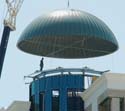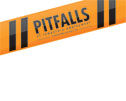Consider these frequently used terms: sustainability, carbon dioxide emissions, greenhouse gases, carbon footprints, cool roofing, climate change, Title 24 and energy rebates, to name a few. Each of these connote a necessary change in our political, environmental and economic thinking, and they all can affect building envelopes—especially roof systems.
The recent confluence of these political, environmental and energy-related issues has afforded many opportunities for reflective roof coatings. (Reflective roof coatings have solar reflectances greater than 0.70 and thermal emittances greater than 0.75, according to ASHRAE 90.1, "Energy Efficient Design of New Buildings Except Low-Rise Residential Buildings.") Being aware of these opportunities may allow you to generate new business for your company.
A few definitions
Although the terms "sustainable," "cool" and "green" are being used more frequently in the construction industry, defining these terms can be confusing.
Webster's New World™ College Dictionary defines "sustainable" as: "designating, of, or characterized by a practice that sustains a given condition, as economic growth or a human population, without destroying or depleting natural resources, polluting the environment, etc."
This definition is problematic for the construction industry because it is so nebulous. And the question that then arises for roofing professionals is: How does this vague concept relate to building envelopes—specifically, roof systems?
During a sustainable low-slope roofing workshop held by Oak Ridge National Laboratory, Oak Ridge, Tenn., in 1996, a "sustainable" roof system was more specifically defined as: "A roofing system that is designed, constructed, maintained, rehabilitated and demolished with an emphasis throughout its life cycle on using natural resources efficiently and preserving the global environment."
Focusing on the "maintained and rehabilitated" portion of this definition, it becomes incumbent on roof system designers and manufacturers to consider how roof systems can have long life cycles with accompanying low life-cycle costs. This is referred to as "forward design" and begins with prudent selection of a roof system and roofing materials. A comprehensive understanding of how a roof system ages under normal conditions will provide guidance in selecting roof maintenance coatings and other ancillary products to prolong a roof system's life.
If a roof system is coated—either initially or after some time—and then recoated periodically as the coating slowly erodes as a result of natural weathering, annual life-cycle costs can be reduced dramatically compared with the traditional "install, reroof, tear-off, install" approach. Therefore, with reflective coatings, roof systems originally installed by a contractor can be inspected and maintained as part of a long-term roof asset maintenance program.
"Cool roofing" and "green roofing" are equally confusing terms and sometimes are used interchangeably. However, "green roofing" and "vegetative roofing" also sometimes are used interchangeably.
To help clarify, cool roofing can be achieved by installing a white or light-colored membrane or coating a membrane with a white or light-colored roof coating. A vegetative roof system requires a waterproof membrane and plantings. In addition, considerable planning is needed to account for the likely increase in dead load on a roof because of the growing medium and plants. Moreover, the increased live load must be accounted for when the medium becomes saturated with rain water and plants grow. I believe coatings are a simpler option and far easier to maintain than vegetative roofing.
The phrase "cool roof colors" often is used in marketing to promote certain classes of coated roofing products employing advanced pigmentation technology. However, "cool" is a relative term, especially when used to promote products.
To obtain a clear, objective measurement of the comparative solar reflectance of roofing materials, I suggest you refer to the Cool Roof Rating Council (CRRC). Solar reflectances and thermal emittances of most roofing products are listed on CRRC's Web site, www.coolroofs.org. (The data has been generated by independent third-party laboratories.)
A "hot" issue
There is significant controversy about the much debated global warming issue. Is the climate getting warmer? Is it the result of carbon dioxide emissions? Can it be slowed down?
Regardless of which side of the argument you support, one thing is certain: Urban areas are getting warmer during the summer. This phenomenon, known as the heat island effect, has been studied and well-documented. Lawrence Berkeley National Laboratory (LBNL) in Berkeley, Calif., even has a Heat Island Research Group devoted to this issue.
And The Group of Eight, an international forum for the world's eight major industrialized economies—Canada, France, Germany, Italy, Japan, Russia, the United Kindom and the U.S.—has issued a long-term goal for reducing carbon dioxide emissions in their countries.
These developments provide an opportunity for reflective roof coatings to demonstrate their abilities to reduce buildings' heat gain and electric consumption and help reduce the heat island effect. Cooler roofs transmit less heat into buildings and can help reduce air-conditioning electricity costs.
The California Energy Commission has concluded reflective roofs can reduce a building's energy use by 20 percent and save consumers money—the potential annual energy savings in the U.S. is in excess of $1 billion. Additionally, when electricity is conserved, less carbon dioxide is emitted from power plants.
In a study to be published in the scientific journal Climate Change later this year, LBNL estimates that replacing nonreflective dark roofing materials with reflective ones on an average building with a 1,000-square-foot low-slope roof system would result in a carbon dioxide offset of 10 metric tons annually. With an offset value of $25 per metric ton, that could save a building owner $250 per year. Obviously, benefits would be greater in places such as Phoenix, where air conditioning often is used throughout the year.
Because reflective coatings can help cool the earth, LBNL has proposed an international "cool cities" campaign to organize 40 of the world's largest cities in tropical and temperate zones to develop programs requiring reflective coatings and cool-colored pavements—which also can help reduce heat islands—when roofs are initially constructed and pavements installed.
The projected estimate for worldwide carbon dioxide emissions in 2025 is 37 billion metric tons; a proposed global carbon dioxide offset from reflective coatings and pavements would be 44 billion metric tons valued at $1,100 billion, enough to offset more than one year of total global carbon dioxide emissions.
In addition, California is promoting reflective coatings through its Title 24 legislation, which was updated in November 2005 and is the most recent step in California's move toward increased energy efficiency. The legislation is to be updated again this year, and changes will go into effect July 1, 2009.
Since 2005, Title 24 has required commercial buildings with low-slope roof systems to have reflective coatings. And beginning in 2009, Title 24 will require new residential roof systems and all retrofit constructions in California to have "cool-colored" roof systems that reflect more of the sun's rays than current roofing materials of the same color. These programs and mandates provide opportunities for the use of reflective roof coatings.
Energy rebates
It is a fact that electrical utilities do not want to build new generating capacity, primarily because it is a costly, long, bureaucratically ridden process. And according to ORNL, one-sixth of all electricity consumed in the U.S. is used to cool buildings.
This past summer, Texas electrical utilities deregulated their pricing schedules for electricity to all customers. This created a dramatic increase in the price of electricity. Other states are expected to do the same, and commercial building owners are pursuing all routes—reflective roof coatings being one example—to reduce electricity costs.
Reflective roof coatings (and membranes) have demonstrated their ability to reduce air-conditioning costs when used instead of dark roof surfaces such as asphalt, polymer-modified bitumen and EPDM. This first was demonstrated on a large scale through cooperative research conducted by Rohm and Haas, Philadelphia; The University of Southern Mississippi, Hattiesburg; and Mississippi Power Co., Gulfport, in 1985. This fundamental and groundbreaking energy study of reflective roof coatings, titled "Building for the Future," clearly demonstrated the ability of a white surface to not only reduce peak demand by reflecting the sun's rays but also cause the peak demand to occur later in the day.
Insulation issues
It is common knowledge that incorporating more insulation into a roof system will reduce a building's heating and cooling costs.
However, "Energy Factors and Temperature Distribution in Insulated Built-Up Roofs," a document produced by the National Caucus of Environmental Legislation in February 1981, concluded a built-up roof membrane applied over insulation having high thermal resistance will be subject to higher temperatures than one placed over insulation with lower thermal resistance. Higher temperatures are likely to reduce a roof system's service life by accelerating decomposition and embrittlement of bitumen. Therefore, an optimized roof system would employ a highly reflective white roof coating surface to protect the membrane and heavily insulate the roof to reduce heat transfer from inside the building.
The report also stated color directly affects solar heat response and radiative cooling of a built-up roof and a white surface has the lowest temperature.
Although this was known to the scientific roofing community in 1981, it is now becoming much more relevant. In 1981, reflective roof coatings were limited to use only on spray polyurethane foam roof systems. Now they are installed on all types of roof systems.
Program opportunities
The U.S. Green Building Council's Leadership in Energy and Environmental Design® (LEED) Green Building Rating System™ is a prominent benchmark for achieving sustainable construction.
Of the total points achievable for LEED ratings, only one point is devoted solely and directly to roof systems. LEED requires a minimum solar reflectance value of 0.78 for low-slope roofing and 0.29 for steep-slope roofing.
Additionally, the U.S. Department of Energy's ENERGY STAR® program, which has become a recognizable and valuable tool for making informed decisions regarding electrically operated appliances and other equipment, offers some opportunities for reflective roof coatings.
The ENERGY STAR program, originally developed in the 1990s, has been upgraded to include more rigorous standards for reflectance and thermal emittance. Although the solar reflectance requirements have not changed, other requirements have been implemented. Most notably, the previous version did not require listing of products' thermal emittances, but the new version does.
The previous version also allowed aged solar reflectance to be measured after cleaning a roof. This could yield erroneous results as roofs typically are not cleaned during their service lives. The new version does not permit cleaning before measuring aged solar reflectance.
A word about cleaning: Some controversy exists regarding cleaning a highly reflective roof surface to restore its original solar reflectance. For example, it often is extremely difficult to get a building owner to inspect a roof twice a year, much less clean it. Also, improper or aggressive cleaning may damage a roof surface, especially aged seams and termination points, resulting in leaks.
Additionally, Florida Power and Light's (FPL's) Business Building Envelope Program is providing incentives for roofs with reflective surfaces. This incentive program is financially beneficial; the building owner receives a rebate, lowers his or her energy bills yearly, and lengthens the service life of his or her roof system.
The FPL incentive for applying a reflective roof coating to a building is $0.45 per square foot, helping save money on a building owner's FPL energy bill. In addition, approved coatings also protect roofs from harmful ultraviolet rays, which helps extend roofs' life cycles. To receive the incentive, coatings must meet ENERGY STAR requirements and have an aged solar reflectance of at least 73 percent as listed on CRRC's Web site. Only a small number of roof coatings meet this demanding requirement.
Future growth
Reflective roof coatings no longer are considered ancillary products. Once used only in warm climates, reflective coatings now are used throughout the U.S. Continued emphasis on political, environmental and energy-related issues likely will further drive interest in and, more important, use of reflective roof coatings.
William A. Kirn, RRC, is technical director of National Coatings Corp., Camarillo, Calif.



